CLOSE YOUR EYES. IMAGINE A BEAUTIFUL, ROLLING VALLEY: TWO RIVERS converging on its floor. Miles of tall grasses wandering in the wind. The valley slopes are wooded with flowering linden trees, oak, fir, spruce. Maybe you see a wild hare darting behind a white beech. Wild boar, red deer, and pheasants graze in the shade of the forest. Brown bears and wolves hunt these woods, but you will not see them today. High above the treetops, you spot a short-toed snake eagle bothering a Black-winged kite away from her territory. Slow moving water murmurs nearby in the moat of an ancient stone fortress. You might imagine you have discovered quite a slice of paradise right here on Earth. Open your eyes: you are standing in the Czech Republic, 37 miles and 43 minutes north of Prague, just outside the dilapidated, almost-ghost town of Terezin.
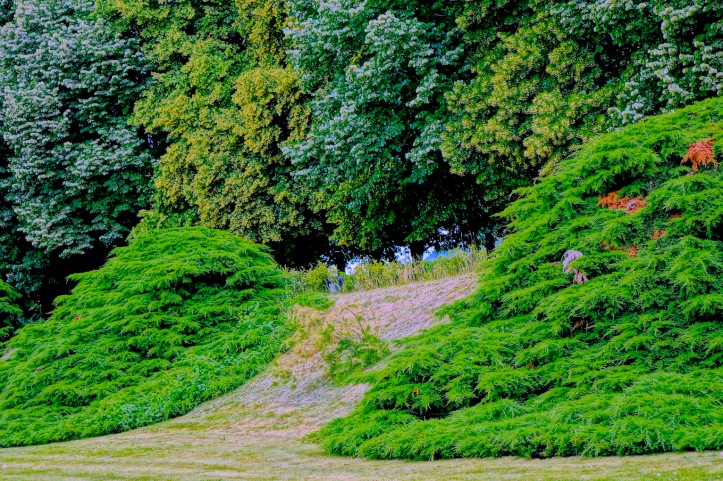
This land carries its history like water. The territory was ruled for centuries by the Roman Empire, and numerous others before and after them. Maybe a thousand years ago, the Czechs sloughed off outside rulers and set up their own monarchy, the Premyslid dynasty. Good king Wenceslas, from Christmas carol fame, rules this land in the early 900’s.
It changes hands a number of times, and in 1526, the Habsburg dynasty washes in. A few hundred years drift by: the territory runs through some turbulent currents, some ruthless ripples, some calming eddies. Prague surfaces as the capital of the area, people sail into the city from the countryside—life happens, shit happens, and then, Prague submerges beneath the surface of its own Dark Age.
The Industrial Revolution cascades the city back to life, and the area named Josefov, the Jewish Quarter, is added to Prague on the high east bank of the Vltava River. Thousands of Jews from anywhere surge into the city on waves of prosperity. Everyone thrives in the peaceful tides of cohabitation. In 1780, Joseph II, the latest Habsburg Emperor, begins building a fortress north of Prague, meant to ward off Prussian attacks on Bohemian lands. He names the star-shaped fortress Theresienstadt, after his recently-deceased mother, Holy Roman Empress Maria Teresa—also the mother of Marie Antoinette, her fifteenth child. The fortress is moored in that beautiful valley where you now stand, near the confluence of the Elbe and Ohre Rivers and is known today as Terezin.
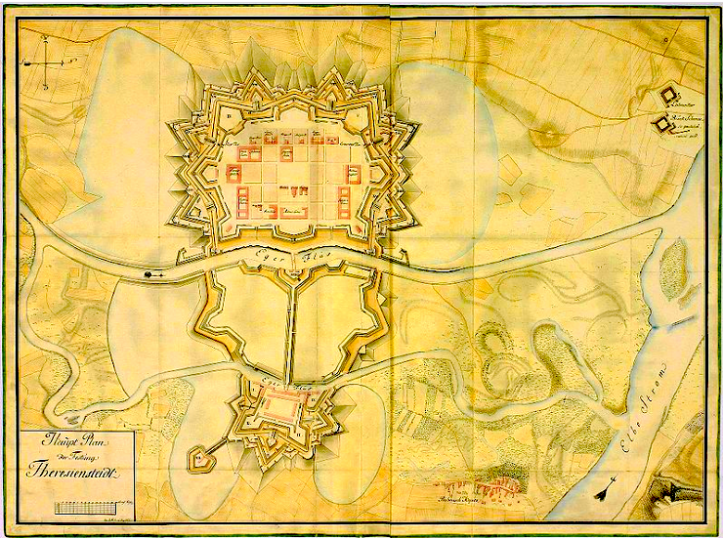
Built in two sections, the fortress straddles the Ohre River and contains a walled town, or Main Fortress, lying on the west bank of the Ohře; and a Small Fortress, the citadel, lying on the east bank. The town is laid out in perfect square blocks and straight streets, the usual Habsburg style of town planning: no Parisian curves, no British roundabouts, no Maltese slantings, no Blaricum meanderings—perhaps a vivid physical manifestation of the rigid, anal quality it might take to run a venerable empire for a few hundred years?

Enter stage right: WWII and Hitler. The Nazis plunge into Czechoslovakia in 1938 claiming the land still belongs to Germany (no star-shaped little fort will stop these guys now). By 1940, the SS decides to adapt the small fortress and town of Terezín as a concentration camp and ghetto. It makes sense: it is already walled and fortified, a fortress constructed to keep bad guys out (ironically, the very same bad guys from the north now wearing swastikas on their arms and skull and crossbones on their hats) and easily converted into a secure prison to keep anyone in: lock the gates, fill the moat with snakes, carry Lugers, fire with impunity.

The next few years do not flow through Terezin with gaiety and good cheer. The message the world hears is that Hitler has built a pastoral city for the Jews, to protect them from the “vagaries and stresses of the war.” Ersatz stores, a bank, a café, and schools are prepared in the town to make it appear as though it is a proper city. A propaganda film (click for three minutes of it) is produced to show the world this idyllic city. The SS transports Jews here from Czech lands and eight other countries, along with “trouble makers” who are not Jewish. At times, maybe 60,000 inmates are crammed in an area built as a garrison for 7,000. The reality of life here is an ocean away from idyllic.


The swastika (sanskrit) symbol is found in ancient cultures around the world, especially India, and depicts prosperity, good fortune, peace, well being. The one on the right is a Native American version. (1)
From Prague, you might take a bus to the town of Terezin and walk to the Small Fortress, as it is known, on the other side of the Ohre. As you walk toward the fortress from the beauty at the main road, even though you know what you know and feel what you feel about visiting a place like this, you almost begin to imagine this is one idyllic area: a lovely valley, two rivers running through it, prime agricultural land, lovely wild flowers, a natural habitat for animals, well-crafted stonework. You can see why the Third Reich’s propaganda worked.

However, a few minutes later, you see what you knew you would see and feel exactly what you knew you would feel. Acres of land, formerly used to grow carrots and potatoes for the Gestapo, and maybe a smidgeon for inmates, is now an expansive graveyard for both Jews and non-Jews slain here. You see 2,386 graves. Jews in one section, Christians in the other. On the other side of the knoll, the remains of thousands more are buried, some in mass graves. Only about 1200 graves bear names.
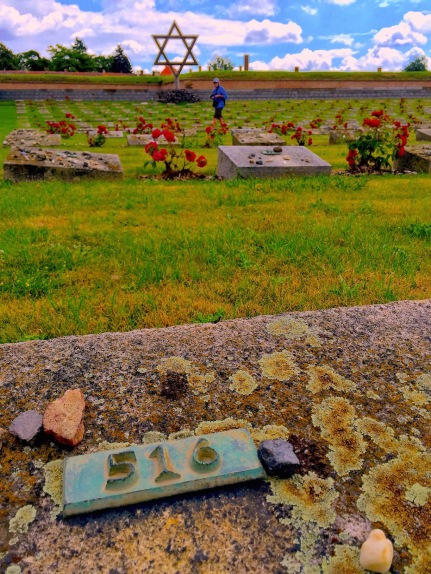

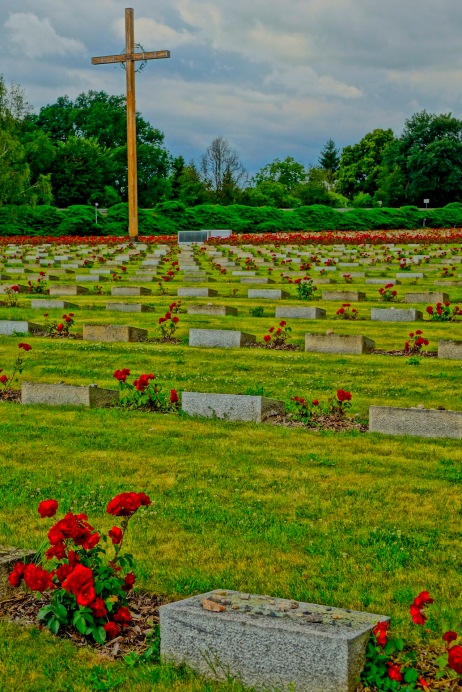
Terezin is not a death camp like Auschwitz, and not technically a concentration camp, like Dachau. There is no gas chamber here—at least, not until very near the end of the war, and apparently, never activated. The SS brings dissidents, artists and musicians, scholars, the elderly, and families to Terezin for “safe keeping” and to work. The sign above the main gate reads Arbeit Macht Frei: Work Sets You Free. People sent here work hard, and many are worked to death. There are four cremation incinerators to accommodate these deaths. Four—at times, they manage nearly 200 bodies a day.
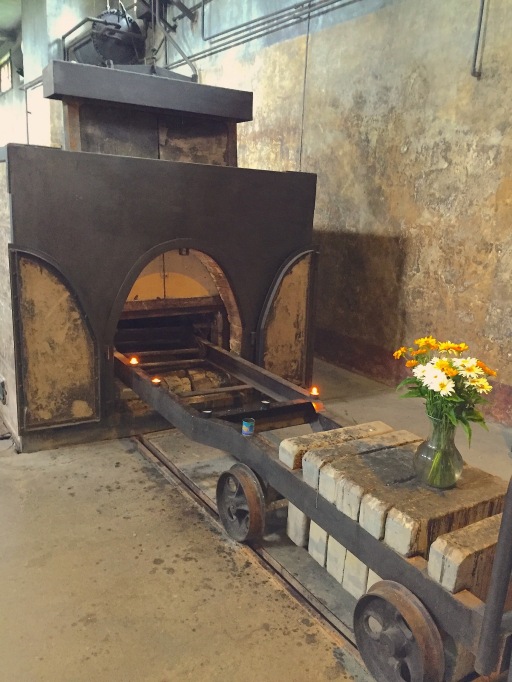

Terezin serves three primary purposes during its three and a half years of operation: firstly, as a way station for Jews who would shortly be deported to actual death camps or forced-labor camps to the east. Secondly, as a model labor camp used to promote propaganda to conceal the annihilation of people deported; the Third Reich maintains the fiction that all deported Jews will simply be employed in labor camps and uses Terezin for these propaganda purposes. And thirdly, the fort becomes a “holding pen” for Jews and detainees, where it is expected many will simply perish from the elements before being sent to other camps. (11)
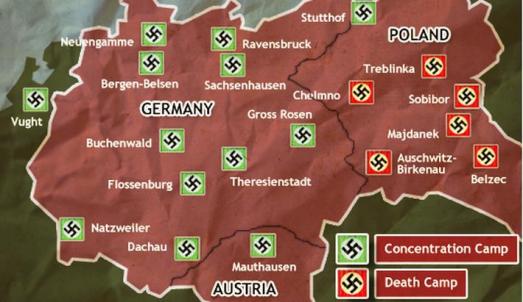
One of those who dies here is Esther Adolphine, Sigmund Freud’s sister; and another sister of Freud, Regina, is transported from Terezin to Auschwitz and dies her first day there.
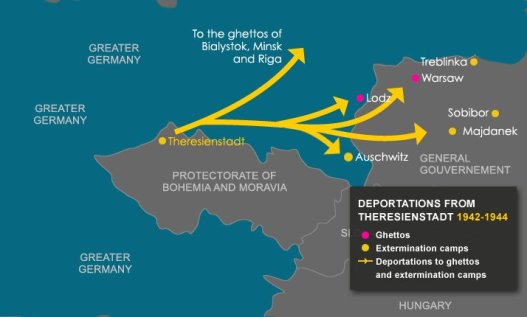
Frans Kafka’s youngest sister and reportedly his favorite and closest relative, Ottla, is sent to Theresienstadt and later voluntarily accompanies orphaned children to Auschwitz, where she dies a few months later. The insightful correspondence between Franz and Ottla is later published as the book Letters To Ottla.

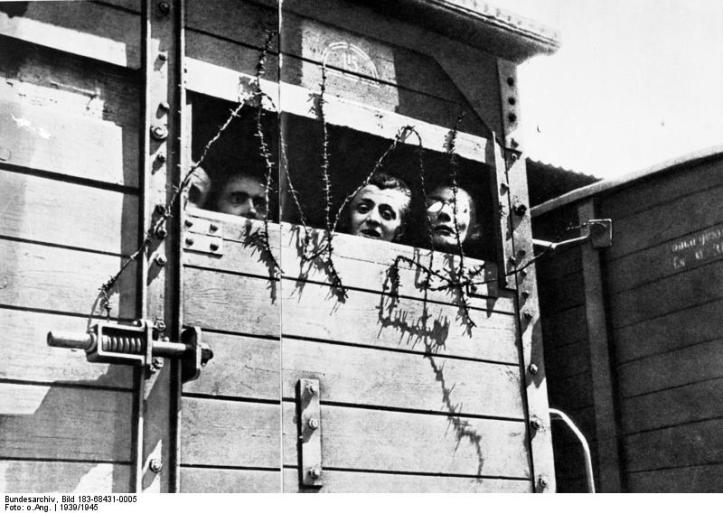
It is estimated that maybe 144,000 Jews are deported to Terezin, most are Czech. However, Jews from Germany, Austria, Netherlands, Luxembourg, Denmark, Slovakia, Hungary, and Poland are also sent here. Many of the inmates die in Terezin, most from the oppressive conditions: starvation, exposure, trauma, inhumane and overcrowded accommodation, overwork, and of course, lack of medical attention and various diseases that attend this many people housed in such small and confined spaces. Some 35,000 inmates—close to 1 of 4—die here in 3 ½ years (by comparison: during Dachau’s twelve years of operation, 32,000 die). From Terezin, something like 90,000 are shipped off to Auschwitz and other camps to the east. By the end of the war, only 17,000 inmates survive; it is believed about 15,000 children once lived here; of those, 132 survive.
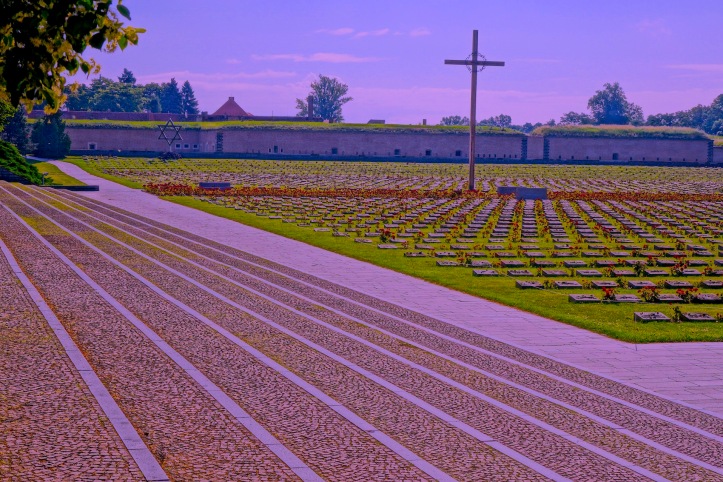
Just before you reach the fortress walls, you see what you knew you would see—the harsh reality harbored at the edge of humanity; however, you are not exactly sure what you now feel. It has nothing, really, to do with death. Or even the deaths of so many. It’s more about injustice, or despotism, or the sheer voracity of cruelty the human animal seems so capable of—given the opportunity, or desire, or consent, or need. It’s difficult to describe this feeling, this unpleasant emotion, this discomforting notion: perhaps, a disquieting dull ache, welling deep inside.
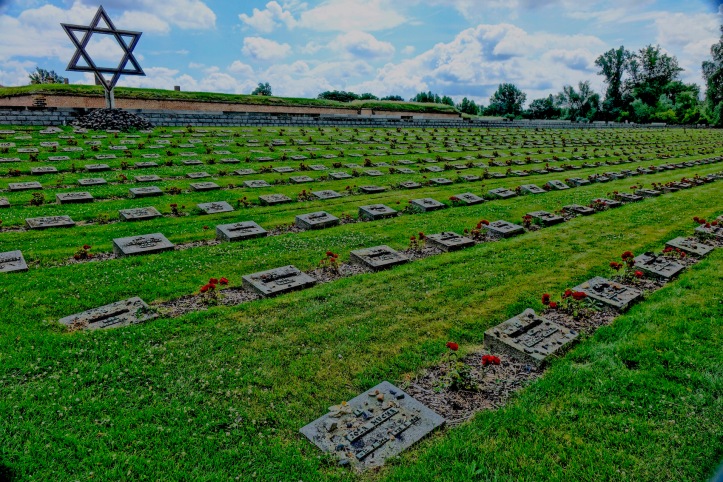


You cross the stone bridge spanning the moat and slowly walk toward the arched, stone-wall entrance to Terezin’s Small Fortress knowing this is not an amusement park, knowing this is not adventure travel at its wildest, knowing this will never make a top-ten list of tourist traps, knowing you will not buy a fridge magnet, knowing that the next couple of hours will not be remembered as the “blissful, gay times” on this particular sojourn. But what you don’t know at this moment is just how profoundly you will be affected by the time you board the bus back to Prague and ride away from this place.
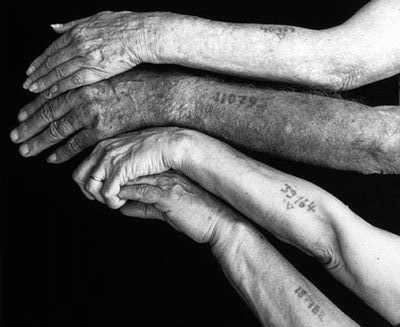
If you care to visit Terezin Memorial, you can find information, opening hours, ticket prices, as well as make reservations (well advised) here: Terezin Memorial
Or phone them here: +420 416 782 300
NEXT WEEK: TEREZIN, PRISONERS IN PARADISE–PART II
More DP Photo Challenge here: Edge
More Lucile’s Photo Rehab here: Photo Rehab
Resources:
Main source: Ghetto Museum, Terezin, Czech Republic and Terezin Memorial: http://www.pamatnik-terezin.cz/en?lang=en
(1) Swatikas: Wikipedia
(2) 1790 map: Wikipedia
(3) MAP2 http://czechoutmyprauge-ress.blogspot.ae/
(4) NAZI FLAG PRAGUE national Museum, Clock Tower
5 Nazi Camps: Holocaust on emaze: https://www.emaze.com/@ALWZLFQR/The-Holocaust
(6) deportations from Terezin: http://www.theholocaustexplained.org/ks4/the-nazi-impact-on-europe/theresienstadt-a-case-study/deportations-to-and-from-theresienstadt/
(7) Frans & Ottla Kafka: Marbach und Bodleian Library/Wikipedia
(8) women/train: https://commons.wikimedia.org/wiki/Commons:Bundesarchiv
(9) Mote/gate Terezin Memorial: http://www.pamatnik-terezin.cz/
(10) Tattooed arms: https://www.pinterest.com/pin/290904457153681299/ saved from Elephant Journal/etsy.com
(11) United States Holocaust Memorial Museum: https://www.ushmm.org/wlc/en/article.php?ModuleId=10005424

It isn’t exactly a “like” like, so much as a well done piece. I visited Dachau right after Andrea was born. I know what you’re talking about. Man’s inhumanity to man is one of those things any conscionable(sp) person finds difficult to grasp. It still makes me sad. A friend at 14, introduced me to her parents who showed me their tattoos and told me their story. They were one of the ones who’d survived Auschwitz, I believe it was. The young lady from France, that stayed with me recently said there is still much animosity toward Jews in Europe, though she was specifically speaking of Paris.
Dachau was not as colorful as Terezin. There were no flowers or graves like that, just gas chambers, ovens, barracks and the infirmaries where they performed atrocious experiments on prisoners. Thank you for the reminder.
LikeLiked by 3 people
I don’t know what Dacau is like, but Terezin is a town right next to and inside the walls. So maybe there is some sort of humaneness happening there? Still, it’s not a beautiful place, but the surrounding land is nice country. Why did you go to Dacau?
LikeLiked by 1 person
Hal and I had planned a trip to “Europe” which really amounted to just Switzerland and Germany with a stop in Austria. He pretty much planned the itinerary with another pilot friend. They are both of German descent and wanted to do the rails and see the country. He was never easy to travel with like you were. He was sick and grouchy most always. It was still an adventure and very interesting. That was the only time we hit Europe, though he went several times with the OW.
LikeLiked by 1 person
Got it, but “ouch”…traveling with a grouch is not fun, not real travel. It’s more like dentistry with pliers and chisel. But right…an adventure is an adventure, and it is what it is. And fun in its own way, maybe.
LikeLiked by 1 person
Some would say this never happened. Others would say this could never happen again. At the same time, the wind spreads the seeds, the roots regenerate and the snakes in the moat have no heads to cut off.
http://www.azlyrics.com/lyrics/rollingstones/sympathyforthedevil.html
LikeLiked by 2 people
man, you are so right on this one…and, sympathy for the devil…one of my favorites
LikeLiked by 1 person
This was a very important post. People sometimes say such things were a product only of a particular time in history or that there is something peculiarly militaristic about German culture which means similar evils could never arise anywhere else. I don’t believe that. I worry a great deal about the burning intolerance I read about every day and in countries all over the world– very often fanned by politicians who should know better. 😦
LikeLike
Politicians are keeping the flames alive so to keep us subservient and thinking we need them. If they didn’t put their two cents worth in, if it’s even worth that, we would all do fine. My friend from France says it’s the politico’s that keep things stirred up all the time and as I read blogs from all over, it’s worldwide.
LikeLiked by 1 person
I think it’s definitely the case that if there’s the tiniest little division or bad feeling in a society, an unscrupulous politician will suddenly appear and exploit it the maximum solely as a means to power. I don’t know how such people can sleep at night.
LikeLiked by 2 people
I agree.
LikeLiked by 2 people
right…maybe they don’t sleep,
LikeLiked by 1 person
Jolie…I think you and your friend are right. Look around. Are things better now than a hundred years ago?
LikeLiked by 1 person
I think they could be better without interference. Having lived in the south, I know that many whites bend over backwards to kind and fair but media and politico’s paint a different picture which then makes it harder for blacks to accept the change. It’s a tough nut to crack.
LikeLiked by 1 person
Jeez…it’s like one step forward, two back
LikeLiked by 1 person
It is very frustrating.
LikeLiked by 1 person
Maybe we should all go live in monasteries and meditate or levitate into some higher animal form…
LikeLiked by 1 person
Thank you Bun, for a very un-Bun response. In general, I find most people very cool, very friendly and concerned about others. It’s those few, it seems, who float (or scratch and claw) to the top that seem to be missing that quality sometimes.
LikeLiked by 2 people
People are so sure this kind of thing could never happen in the US. It already has. Look at what we did to the Native Americans… And with all the hate that’s being preached here lately, it’s likely to happen sooner rather than later… Most human beings are sheeple, not people.
LikeLiked by 1 person
I know, and isn’t that almost the saddest thing. It is nothing new. And it continues. Everywhere you look. “Sheeple”…that is right on, I’m afraid. But the problem is not with them. It’s the wolves who eat the sheeple.
LikeLiked by 1 person
That’s true, too… Unfortunately.
LikeLiked by 1 person
lemmings over the cliff…
LikeLiked by 1 person
I feel we all have a good and a bad side to our nature. Our default setting is to be kind toward and concerned for others, but we can be provoked by fear and ignorance into acting very cruelly. I know in the real world, things can be a little more complicated than this, but think that at root, this is what’s going on.
By the way, I’m sorry to have suddenly turned so po-faced! I’m happy to joke about most topics, but sometimes it just doesn’t seem appropriate. Don’t worry, though. I’ll be back to normal by your next post. 😀
LikeLike
“Arbeit Macht Frei” is the slogan of the ‘free’, capitlist world.
Politics aside: some side boob is always nice. 🙂
LikeLiked by 2 people
Side–yeah, would of been great with a tat though, eh.
LikeLike
Yes: side boob with tat is a winner!
LikeLiked by 1 person
as long as it wasn’t a spider web and black widow, or a cobra
LikeLike
This was such a beautifully written post, BadFish. I like it in the way that you brought such an emotional reading to the table. So sad and awful and hateful, what happened, but such sobering writing. The last photo…..
LikeLiked by 1 person
Thanks Loisajay! I usually try to insert a splash of humor no matter the subject, but for this post, the humor just never quite surfaced. You’re right…so sad, and awful and hateful stuff going down.
LikeLike
Badfish:::: pleased to see kafka made it to the Cafe even if you werent exactly channeling him. but them knowing now, thanks to you, that kafka’s sister went to austwich, that explains a bit about him. i never ever wanted to go to prague after reading kafka as a teenager. but then i didnt know scotsmen with whips would be waiting outside starbucks. ( hold 5, i STILL dont wanna go.)
moving right along – this is a sobering piece, beautifully written, love the first line ” wears its history like water”. such a beautiful first photo. such a sobering reality.
and i must ask, sorry, but the woman at the top, is she a chef with a face highly resembling Angelina Jolies? ( if so, i can say – ‘you found her’!! 🙂 )
look forward to the next installment Baddie.
LikeLiked by 2 people
Deb…thanks so much. But I’m wondering if maybe Kafka wasn’t channeling me, because this is not what I would normally write. And just why do you not want to go to Prague? It is hands down, one of my favorite places. I walked all over that place day and night for days. Even after my feet got so sore they hurt constantly from walking. Then, I rented a bicycle for two days and kept going. The girl at the top can’t cook and looks more like Mo Howard of the Three Stooges than Angelina
LikeLike
Thank you for this, Badfish. It is not something that could never happen again. Intolerance raises its ugly head every day all over this globe. It is scary to think of it. Politics as they are today is not a comforting thought. I am reading a novel right now about a woman violinist who went to Birkenau for trying to help some Jews escape Austria. It was brave of you to make that pilgrimage. Thank you for sharing it with us.
Respectfully,
Mary
LikeLiked by 2 people
And by the way, great photographs!!
LikeLiked by 1 person
Mary, thanks and I’m glad you mentioned “pilgrimage” because that is quite exactly what it felt like to me, and I’m not sure why. I’m not Jewish, but I am, apparently, human with a sense of right and wrong, and perhaps a bit too emotional about some things. What’s the name of the novel, is it based on real life?
LikeLike
This is a powerful, moving piece to wake up to on a Sunday morning.
As Ashkenazi Jews whose families either went to the camps (and never came back, the majority..) or miraculously escaped to distant lands, we have tended to stay away from not only vestiges of Nazi extermination camps and movies and books (no need for reminders in our case, we are pretty well versed on what happened). We get pretty frustrated with our fellow Jews and family members who defiantly state “Never again!” because our global travel has shown us quite the contrary. Namely, that evil resurfaces regularly in many different forms ~ ~ Polpot in Cambodia, Agent Orange in Viet Nam and as this past weeks acknowledgment by President Obama while visiting Laos, a secret war that managed to drop more bombs in Laos than were dropped in all of World War II. Currently, the horrors of Syria are barely making news anymore. The specific tools of mass extermination (gas chambers) should not be distinguished from other technical means chosen for massive extermination. Whether by gas chamber or the aerial delivery of mines and bombs, and defoliating chemicals, the end result is the same.
What we appreciate about your post is the sober writing about extermination at Terezin, with a juxtaposition of bucolic rolling hills in the adjacent countryside. The take away “evil lurks not just in dark dungeons and concrete cells, but also in attractive locales.”
Much as we love Viet Nam, we are quite aware that less than one hour from the quaint charming and beautiful Hoi An, (where we will have a home base) the American military staged an enormous military base in Danang and stored enormous quantities of Agent Orange and other chemicals, which today continue to leak through the water system and earth resulting in continued birth deformities.
Thank you for the thought provoking, very well written post.
Ben & Peta
LikeLiked by 2 people
Ben and Peta, my friend from France’s mother is Ashkenazi Jew and although my friend, is quite young, she is still quite aware of the pain and history. She says, that although the French were allies, they were notorious for shipping their Jewish population to Germany. They, in fact, weren’t the only ones which is something most of us are unaware of.
Truth in all that you say. Evil does lurk in different forms and we see it everyday.
LikeLike
I wonder if the French shipped them because they believed the propaganda? Or were they simply forced to send them as they were occupied by Nazi troops.
LikeLike
I don’t know. But, she has felt the disdain. I told her, don’t bring it up. BUT, I met a young man and sister who have migrated here and they say there is considerable prejudice there.
LikeLike
where, France/Germany…against whom?either way…I wonder when/if that will just stop being what we do
LikeLiked by 1 person
She’s in France near the Spanish border and the prejudice is against Jews still. And, sadly there will always be some but I don’t think it would be as bad as it is if it weren’t for those that benefit by keeping it going. I think overall that people are far better than that. I really do.
LikeLiked by 1 person
Oh, yeah, I hear you. People can be better. Maybe sometimes we just revert back into our lizard brains and act like Komodo dragons for awhile–they eat their young?!
LikeLiked by 1 person
Both. There was a strong anti semitic culture that existed prior to Hitler’s rise. Much as there was in Spain, Italy, Holland, Portugal etc. And at the same time, France like Poland before it, Holland, Belgium etc. did not have the military capability to resist German advance. Let’s be clear, much as it is fashionable today to point to the rise of the extreme right in France as just an extension of an anti semitic past, the facts remain that many French Jews like Ben’s mother and grandparents were saved repeatedly by French Catholics – nuns and laymen who helped hide and feed and provide logistics to Jews on the run, in their quest for survival from the Nazis.
Peta
LikeLike
Peta
thank god…there are GOOD people on the planet, too.
Where are you good people, now?
LikeLike
Ben & Peta…and thank you so much for your remarkably sober response. You find those words, “Never Again” in much writing about the Holocaust. But you are right. This destruction of human life has continued and is still continuing…the method of execution (in both senses of that word–carrying out, killing) changes maybe, but the result is the same. I just don’t understand the logic, the reasoning behind it. Maybe that’s the point, it’s illogical, an aberration. Agent Orange scares me. So does a 9mm Glock.
LikeLike
We just arrived in Viet Nam. Stay tuned!
LikeLiked by 1 person
http://www.greenglobaltrek.com/2016/10/slipping-comfortably-into-life-in-hoi-an-viet-nam.html
LikeLiked by 1 person
What local costume is Ben wearing now?
LikeLike
I’m left with a terrible feeling of sadness. There’s no place to hide in here.
LikeLiked by 1 person
It’s just indecent. What can you do? Where can you go? What is wrong with some people, maybe, is all we can ponder. And try to move forward in peace and harmony.
LikeLiked by 1 person
A powerful and moving piece BF, but I’m still left wondering about the clickbait photo at the beginning.
LikeLiked by 1 person
Don! Good to hear from you. And thanks. But I had to look up the word “clickbait”…didn’t know what it meant, never heard/read it before. But yeah, clickbait it is, but mostly merely as a juxtaposition or definition for “decency” or the bordering on it. Most of my readers, apparently, are women, so there was no real clickbaition happening.
LikeLike
In the midst of a fancy-free, lighthearted romp through Eastern Europe a few years ago, my daughter and I spent a day at Auschwitz. It was as if we threw a gray blanket over ourselves – we went silent, we paled, we walked with glazed eyes, and we didn’t recover quickly. For all those who can’t visit these kinds of places, there are others who see it almost as a duty to witness the kind of inhumanity we are able to inflict upon each other. Your post cast that same pall over me as I read, and as much as I did not enjoy reading it, I did so much appreciate reading it.
LikeLike
Lex, I was soooo glad to read your first few words: “fancy-free, lighthearted romp.” Because writing this post took a huge hunk of something out of me. Or shrouded me in one of those gray blankets, and silenced the inner me. Writing this post did not come easily, nor quickly. I have to admit, though, I did not see it as a duty to see this place, but I am saddened that we humans continue to be so inhumane, and I’m gladdened that some people appreciate…jeez, how do I finish that sentence?
LikeLiked by 1 person
I get it.
LikeLiked by 1 person
The 15th anniversary of 9/11 has put me in a thoughtful mood, which makes for a perfect reading attitude for this piece. I enjoyed it, very much. Curious non sequitur opening, though.
LikeLike
Yeah, the curious opening (you mean the photo, I think? or all that about the landscape?): either way, right…curious, indeed. As for the writing, that is simply what came out when I sat to write. As for the photo…it’s about the bordering on decency, indecency. But now I’m looking at it, I think maybe it should not be there?
LikeLike
No. It should be there because you intended it to be there. I’m going to be impertinent and offer an opinion (ahem…). I figured the photo was a deliberate choice and not because you wanted to post a playful piece of silliness just cuz you are a BF. I thought it was perhaps commentary to go with your opening description of a lovely valley that disguises an ugly history; the thing that captures you and drags you in. Providing readers with just a tiny bridge from your well-thought out reason is all that’s needed, like you told here to me. Please know it’s really a good post and I mean it when I say I enjoyed reading it. Most especially because you didn’t mention thongs, poop, or lythe female cooks (OH! Wait! Is SHE a cook?? Now I get it!)
LikeLike
Deep, haunting and educational. Brilliant post, Badfish — not for the subject matter but for the remembrance, awareness, your words, your feelings, everything. Thank you.
LikeLiked by 2 people
Kelly…a rather odd thing is that when I was there, I believed I would not be writing a post about this place, I thought there would be no words (like taking a picture of the Grand Canyon). The experience was so haunting (as you write) that it is still with me.
LikeLiked by 1 person
Wow, this is so different from your usual posts and not at all what I expected. But brilliant, and beautifully written, and very moving. I love love love the three paragraphs beginning with “This land carries its history like water”. What a beautiful flowing way to encapsulate a long history into a few words. And what a perfect way to begin your story. I usually avoid places of past extreme cruelty. We didn’t go to the killing fields in Cambodia. It’s too much for me. I know how unspeakably cruel we humans can be. The power of it can be overwhelming. Nevertheless I look forward to the next installment. Wonderful photos. Some of them seem quite purple. Was it deliberate? It works well.
Alison
LikeLike
Different, I know. I usually do like to add a flavor of humor, but this piece…well, the humor simply did not surface. The best I could do was insert the photo of the lady, depicting decency and paradise…perhaps poorly as Don is wondering. And I, too, avoid places of cruelty. I never visit dungeons in castles with implements of torture, and charge an extra entrance fee to boot! I don’t want to see it, I certainly don’t want to pay more to see it. In Cambodia, I saw where the killing fields were, but did not wander near them. The photos…yeah, I have been using iPhoto edit thingy. It’s easy and the photo simply pops into it (I don’t even know how to get a photo into LR). The light was fine in the photos, but…well, I added some color to make it appear “different” more…I don’t know, more like the way I felt as opposed to the way it actually was. I did not feel normal there. I felt a little off kilter there, and a little off kilter when I wrote this piece, and still a little off kilter now as I remember. Apparently, I am not a man’s man, like Hemingway or Hunter S. Thompson!
LikeLiked by 1 person
The last sentence – I’m glad to hear it.
LikeLike
PS Sorry to be a PITA, but thought you might want to know – mote=tiny spot, moat=water around a castle. I splained the opening shot to Don 🙂
A.
LikeLike
What’s a PITA (oh wait…pain in the…got it). But Jeeez, thank you for catching that. You know I just hate (almost as much as you) spelling errors. I usually look things up if I’m not sure, but I just let that one slip. AND, I know I can count on you (and sometimes Don) to fix me up!! Thanks again.
And thanks for keeping Don straight, too, but I’m interested in how you splained that opening shot to him, Lucy.
LikeLiked by 1 person
I said it is an image of the “edge of decency” as in the title.
I also hate punctuation and spelling errors so if you ever see any please let me know.
LikeLike
What an illuminating post. The way you weave the history and then the effect of the history is thoughtful–and not easily so. Visiting such places–and with the context of history in mind–makes us consider so many things at once, how they fit, what life means. You did it beautifully, without being glib.
LikeLike
I’m glad you liked it in the way you liked it–history affecting us all. It was definitely a sobering, inciteful visit, and the effects of it I still feel today. And I’m certainly glad it did not come across as light or glib or insincere. That kind of cruelty is too heavy for that.
LikeLiked by 1 person
Sometimes it’s easy to say what people expect and it was clear you thought much further than that and grappled with it, which is not easy.
LikeLike
“It’s difficult to describe this feeling, this unpleasant emotion, this discomforting notion: perhaps, a disquieting dull ache, welling deep inside.” I always find myself wondering if that feeling (which so many describe) is really an awareness rearing up in us to make us realize that we all have the potential to do unspeakable things. If it is, then we should be thankful we feel that way so we’ll never forget.
`
I’m reading “Hitler’s Willing Executioners: Ordinary Germans and the Holocaust” by Daniel Jonah Goldhagen. It’s quite eye-opening.
`
Thanks for posting this, Badfish. Sometime I really worry we WILL forget. {{{BF}}}
LikeLiked by 1 person
I believe you are right, we all have this potential. And gratefully, we keep it under control for the betterment of mankind. I’m wondering what the book says about “why” the executioners were “willing.” Does it say why?
LikeLiked by 1 person
Believe it or not it talks about a gene that the teutonic peoples have. (Teutonic in the sense of of, relating to, or characteristic of the Teutons or Germans; German, noting or pertaining to the northern European stock that includes the German, Dutch, Scandinavian, British, and related peoples.) Haven’t gotten far enough into it to see how he comes to this conclusion. He seems to be saying that for their part, they’re prone to violence. And of course they’re scattered all over the world now. I’ll have to let you know more when I understand it better. He talks about how a German officer could be so offended if his men were accused of stealing from people, yet they had no qualms about just killing masses of folks. Like their wiring was screwed up somehow. I’ve read a lot of stuff about WWII, but this is all new to me.
LikeLike
DNA…we should of known!!! that makes sense, nothing else does
LikeLiked by 1 person
I’ll have to let you know if he actually proved that. It’s on hold at the moment as I’m beta reading a 700 pager for the fourth book in my friend Christina Ochs’ series. Gotta have it read by October 15. And I don’t read and blog at the same time well…
LikeLiked by 1 person
700-page books push the procrastination button in my psyche…and get left on the shelf
LikeLiked by 1 person
She was the first friend I met on here, and two weeks later we were sitting in N. Salt Lake havin’ a three-hour conversation about writing over breakfast. Her husband drives a semi and she rides shotgun. Has her computer bolted to the dashboard. 😀 They just happened to be coming through. They’re good books. I’m conceited, you know. I get a kick out of seeing my name in the Thank Yous! LOL
LikeLiked by 1 person
have I lost a thread….who are we talking about (am I losing my memory or what?)
LikeLiked by 1 person
Two messages up, my fine fella! 😀
LikeLiked by 1 person
ah, got it…
LikeLiked by 1 person
Beautiful writing. It left an ache in my gut.
A few years back, I read a little book called “The Cat with the Yellow Star” about a girl who had been sent to Terezin. Your photographs helped bring it to life.
LikeLike
Thanks for the tour and for a piece of history. I can totally relate having come from Russia. Even though I was born in the post-war, a baby boomer if you will, my father was drafted and ended up in a POW camp. His sisters, my aunts who I never knew, were killed in the occupied territory.
LikeLike
I first learned about Terezin in WG Sebald’s Austerlitz – which could be a novel, or maybe not – since it travels in mind, body and spirit and PLACE is always an integral part of Sebald’s writing so you never know if it’s fiction or nonfiction (https://en.wikipedia.org/wiki/Austerlitz_(novel). But you have taken us to the terrible heart of things here, Badfish. This is the kind of post that needs to be re-posted at regular intervals. We need to remember the consequences of adoring psychopaths, and lapping up their divisive racist diatribes. And we need to remember this right now! Good work, sir!
LikeLike
As with others, my “like” is for your excellent post. G&P, Ken
LikeLike
Well presented, never to be forgotten.
LikeLike
What a sad and moving presentation of a place I’ve never even heard of. Your story is powerful and beautifully written. I don’t like to visit places like this, yet I make myself do so; it is vitally important to always keep in mind the horrors human beings are capable of inflicting on one another. I’ve been everywhere from the killing fields of Cambodia to the Holocaust Museum in Washington, and each time I encounter a somber reminder that we, so far, have been lucky to escape atrocities that so many throughout the world have suffered. I wonder about our future; I believe it could happen any time to any of us, and in the political environment in the USA right now, I can see the dangers lurking around the corner. Thank you so much for sharing your experience of this tragic place.
LikeLiked by 1 person
Nomad I…I believe you are right. And you’ve made me realize that I too, have visited sites like this in various places. The Vietnam memorial in Washington DC is a good example, and another example of how it makes one feel when you go there. I think it IS happening right now in various places…
LikeLiked by 1 person
Heartache. The map of the town when it was designed is beautiful. We in the states have no institutional memory of the dangers of demagogues. I hope it isn’t my generation that brings one to power.
LikeLike
Right. We may already have one, but one we are not actually aware is there. Winter is Coming….
LikeLike
Thank you for the time and effort put into a post that had to be emotionally difficult to write. Your efforts are very much appreciated. Well done.
LikeLike
thanks…and actually it did take longer, and was more difficult, than most. I don’t know why.
LikeLiked by 1 person
The research alone had to be very time consuming.
LikeLike
You’re right, and although I got most of it from the Museum in Terezin, I had to double check everything (and things I forgot, or didn’t take notes on), and then I started finding other facts. Usually, I write from the seat of my pants.
LikeLiked by 2 people
That is journalism.
LikeLike
right…and when does the paycheck show up?
LikeLiked by 1 person
Only when you submit the piece to a publisher that pays.
LikeLiked by 1 person
right!!!
LikeLike
Such a sad bit of human history, the photos are absolutely gripping.
LikeLiked by 1 person
Charlie…yeah, gripping, and hard to handle.
LikeLike
Badfish my heart hurts. This is a powerful piece that I’m sure not easy to write. It astounds me at what humans can do to other humans. Then and now. I will admit I am left a bit speechless after reading.
LikeLiked by 1 person
Sue, you are right, of course…it was hard to write because every word hurt to write, and the images of what humans are so capable of doing to other humans. I am so speechless, I do not think I can write the second half, maybe I’ll just do photos. Or go back to Malta.
LikeLiked by 1 person
I do think it important that we all be reminded of what hate can lead to. Photos sound easier on your heart Badfish and a trip to Malta thereafter to recover.
LikeLiked by 1 person
Malta to recover…I like the sound of that.
LikeLike
Well that certainly brought me down to earth from my Bali High. Definitely (beyond) the edge of decency. Thoughtfully and beautifully covered. I wish that this had been the last such atrocity to happen (or better yet, that it had also never happened) but the human race just can’t seem to stop delivering horror. I still believe that dharma will triumph over adharama, but it is taking a lot longer than I would like. I have never visited a concentration camp. I have had the opportunity but lacked the strength. Thank goodness my family emigrated from Poland to the US via Canada before hell broke lose.
LikeLike
Lisa…sooo sorry to bring you down from your High. And I’m just not sure the moral force that orders things here on the planet actually can do its job these days? But hopefully. My suggestion is…don’t visit. I rather wish I hadn’t. “Sobering” is one thing, whatever else that is…beyond the edge of decency…is something else altogether.
LikeLiked by 1 person
It does seem like that ‘moral force’ has taken a holiday. What a crazy shit show this world has become (again). Perhaps it’s an ebb and flow thing. If so, I just hope the tide will turn again soon and bring a bit of peace, joy, harmony and prosperity back to the world.
LikeLike
amen to that, Lisa…but I’m not holding my breath until it happens, just so you know
LikeLike
Such a moving and touching post… it reaches me because I have studied Genocide when I was at the University, and we studied the Holocaust in depth… Besides I have watched many documentaries about thhis subject… nevertheless, my experience is not complete as I have never visited a Nazi death camp… and I guess it would be an overwhelming, deep experience…
thanks so much for such an important post which is also a sort of tribute… as memory is the best tool to avoid things like this to happen again…
Sending all my best wishes. Aquileana 😉
LikeLiked by 2 people
Aquileana, you just never know what might happen next. I don’t understand the concept of genocide, why people believe it necessary, and then have the ability to follow through with attempts. I don’t think it is anything new on the planet. My visit here was…I don’t even know how to say it. But it stays with you. Bless you!
LikeLiked by 1 person
What a very educating post highlighting a very dark piece of history that we should never ever forget. I’ve learned a lot of new things thanks to your post and many things I learned years ago got a refresh thanks to you.
LikeLiked by 1 person
well, I should be glad you learned something from my post, but I’m not so glad we have these things to learn and remember!
LikeLiked by 1 person
Just need to make sure history will not repeat itself…
LikeLiked by 1 person
right…doesn’t seem like us humans care to do that though, does it?
LikeLiked by 1 person
Seems like we never learn…
LikeLike
we’re hard-wired in another direction, apparently…
LikeLiked by 1 person
It was harrowing just reading this post so I can’t imagine how you felt while writing it, Badfish. When I read about places like this, I always wonder how the world could have just let this happen. But of course, it is still happening in different places. Such sadness.
LikeLiked by 1 person
I know…I actually did not realize how writing this was affecting me. I was affected while in Terezin, but after posting this…I could not write the second half. Maybe your psyche knows when enough is enough for your own good?
LikeLike
I think so. I don’t know if I will ever visit places like this. I wouldn’t be able to get the horror out of my head. Just so awful.
LikeLiked by 1 person
yeah, if you’re sensitive (I am), it’s a bit hard on your head.
LikeLiked by 1 person
Very very interesting, didn’t know any of this. Thank you
LikeLiked by 1 person
Thanks, wish I didn’t know any of it, wish there was nothing to know!! Where are the fairy tales when you need them?
LikeLiked by 1 person
Some parts of history that we wish not to repeat. The scary thing, some politicians proposed ideas that might repeating the history.
LikeLike
well, isn’t that just what is happening, and has been? I think. You’re right–scary!!
LikeLike
All I can say Mr. Badfish is Wow! A very sobering reminder that we all need time and again.
LikeLike
keli…sobering, indeed, thanks for sharing and hanging out here
LikeLike
I have no words……..
I do have two book references though. One is peripherally but importantly related and is called Broken for You by Stephanie Kallos. It is actually a delightful story and the connection to your post is a bit obscure, but an uplifting read.
The other is a historically factual novel and one of my all-time favorite books. I reread it when the weight of “darkness” in the world gets too big. It is a good reminder of my deep belief that though some say ALL humans have a dark side and are capable of horrific acts, most are good and filled with light.
The book is called A Thread of Grace by Mary Doria Russell
I guess I did have a few words, but they were about me.
It’s you and your courage and your writing that I can’t seem to find words for….
LikeLike
Kathy, thanks for the books…if I had time, i would read them. Who doesn’t need a little grace in their life? As for my “courage”…no, I had so little, I am unable to write Part II!
LikeLike
Thank you for a sobering, reflective post that I can read from the comfort of my free home. I did not know of this place, well, I’d seen it mentioned in passing in other articles but I’ve never read about it specifically. Great work, adding family members of people we know from the world of arts and medicine helped to bring the horror home.
LikeLike
Dunelight…thanks so much for hanging out here and letting me know how you feel.
LikeLike
A sobering but very important documentation of your visit to this tragic place. I recently visited Auschwitz and my overriding thought on leaving was, ” We ( the human race ) have not yet learned the lessons here. When looking at world events, it sometimes seems that these poor souls suffered in vain. It is very important that everyone knows and recognizes this history. Just yesterday I heard this important words from a survivor who assisted people to escape the holocaust,” I know where hate leads. Be more intelligent than you fear.”
LikeLike
Those are very good words to live by!! Thanks for hanging out and commenting here! Let’s hope the next post is more graceful and uplifting!
LikeLike
Thank you for posting this… I feel it’s essential for us who haven’t gone through such horrors to visit and get informed about such devastating happenings in the past. To see. To feel. To understand. To realize. To fight back. And to make sure it doesn’t happen again…
LikeLike